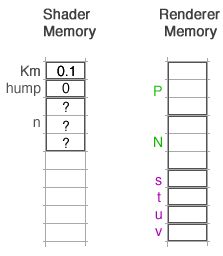Thanks for the Memory
When a shader is used by the renderer it has access not only to itw own
data, which is loaded into its own private memory, but also to shared
data that is maintained by the renderer.
Memory can be visualized as a long sequence of storage containers. Each
container, or memory location, is capable of storing a single
item of data.
For example, the items shown in green P,
N identify
data that a displacement shader can read and modify.
The items shown in purple s,
t, u,
v identify
data that a displacement shader can read but not modify.


